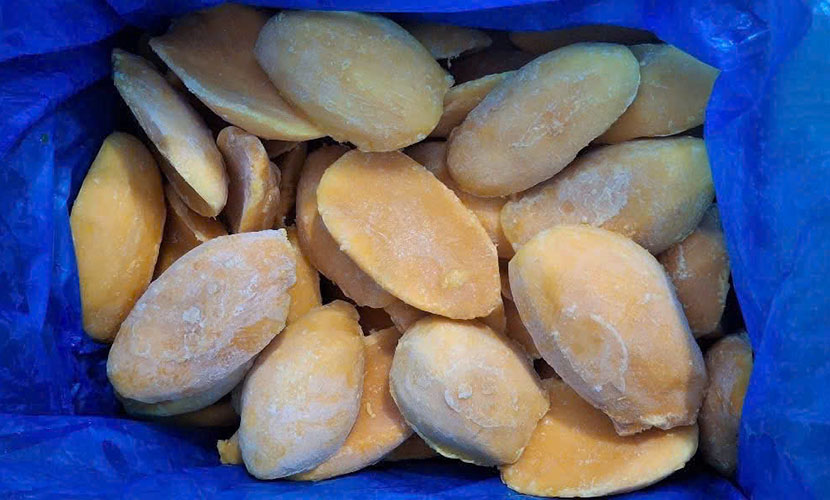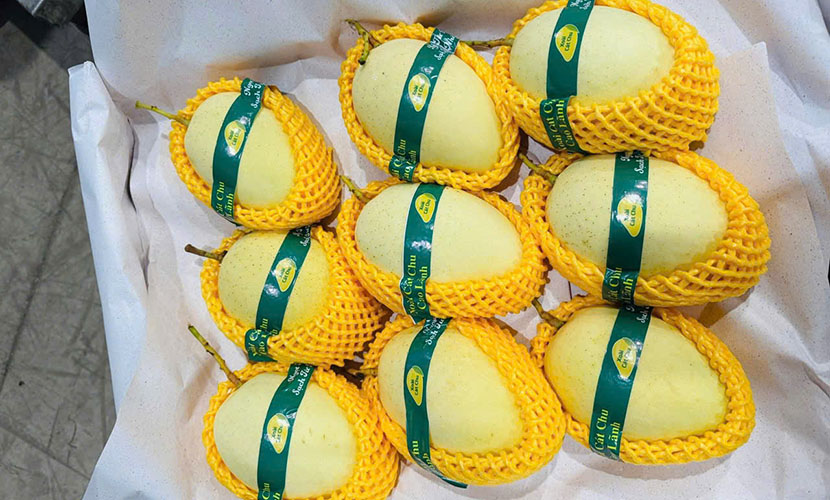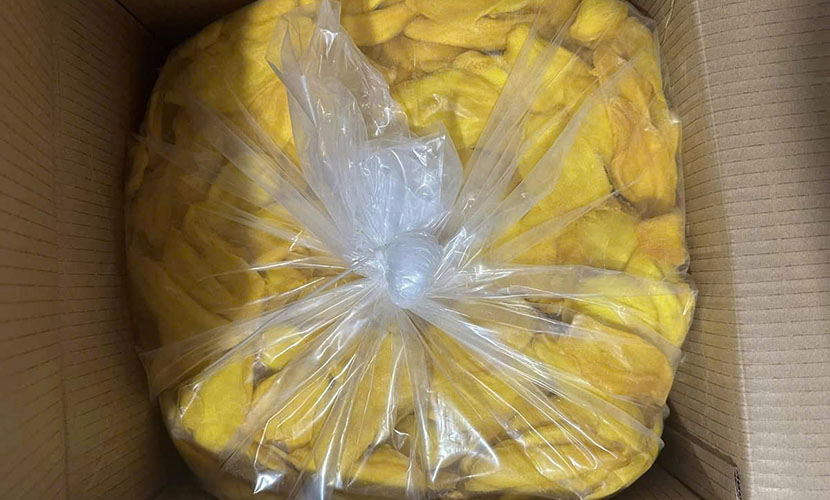
Vietnam owns the big advantages of climate and soil, which are suitable for planting mango trees. Therefore, Vietnamese mango products are increasingly present in many demanding markets around the world. As a result, they have been positioning the brand of Vietnamese agricultural products on the global agricultural map.
Currently, Tien Giang province has more than 88,000 hectares of fruit trees. Of which, there are nearly 3,300 hectares of mango cultivation, with an output of over 50,000 tons. A part of these mangoes serve for the domestic market. The other will export to China, South Korea, Japan, the United States and the European markets.
Cai Be district is the largest mango‑growing district in Tien Giang province. The district plants more than 2,300 hectares of Vietnamese mangoes. Of that area, there are about 260 hectares of Hoa Loc “cat” mango variety, producing nearly 3,000 tons of fruit each year.

Frozen mang from Vietnam
Local farmers have applied the scientific and technical advances in production of Vietnamese mango products. Accordingly, there are nearly all mango growing areas in Tien Giang follow Vietgap standards. In which, there are 57 registered growing‑area codes, covering nearly 1,802.17 hectares. Notably, one growing‑area code for the Hoa Loc cat mango variety covers 52.55 hectares.
The district has invested in renovating and expanding post-harvest processing and packaging plants. It has also equipped certain specialized devices such as heat-treatment tanks, fruit-drying tables, and cold-rooms.
As a result, the Hoa Loc cat mango ensures quality, reduces post‑harvest loss, and increases both value and shelf‑life. Therefore, Hoa Loc cat mangoes have stable selling prices, which are 10‑15% higher than those of other mangoes.
Mr. Thuc, Director of the Hoa Loc cooperative, said the cooperative currently has 139 members and a management area of 80 hectares. The cooperative has developed nearly 20 hectares under Vietgap standards and plans to expand by another 20 hectares.
By joining the cooperative, mango‑grower members receive support on cultivation techniques. Particularly, they include pesticide spraying, flowering treatment, controlling harvest staggering, farm‑bagging technology…
This helps increase productivity and volume, and improve product quality. It also supports research and transfer of storage and processing technology for highly commercial potential mango products.
The recognized first-generation orchard of the Hoa Loc cat mango will help generate high-quality, disease-free planting material at a reasonable cost. This planting material will be provided to markets inside and outside Cai Be district and help enhance economic efficiency for orchard owners.
At the same time, it will help conserve high-economic-value plant-gene resources and affirm the brand. This will also open new prospects for exporting the Hoa Loc cat mango product to international markets.

Fresh mango from Vietnam
In addition, in the effort to promote the trade market for the Hoa Loc cat mango product, Tien Giang province has made notable progress. The product’s approval for export to the United States brought great excitement to mango growers. In addition, the province took further steps to promote it. Since 2019, it has cooperated with Vietnam Airlines to have the Hoa Loc cat mango served on the airline’s flights.
It is assessed that this is an effective channel for brand promotion and trade promotion of the Hoa Loc cat mango. It helps stimulate consumption and contributes to forming a production-to-consumption value chain for the local agricultural commodity.
The Hoa Loc cat mango is currently exported to many countries. Specifically, they include France, the United States, Canada, Australia, Japan, Singapore, Taiwan and China.
The mango export will open many new opportunities, helping local mangoes penetrate more deeply into global markets. It will also attract foreign currency and enable farmers in specialized cultivation areas to build sustainable businesses.
Ms. Lap, Director of a Vietnamese mango business, shared that the company has committed to sustainable cooperation. It aims to deliver export-standard mangoes and increase the value of mango products for local farmers. From the exporter’s side, companies will strengthen strict traceability, produce according to Vietgap and Globalgap standards.

Dried mango from Vietnam
They will connect with inspection and quality‑assessment units to ensure Vietnamese mango products meet import requirements and standards. They will effectively carry out inspection and supervision of the granting, management, and use of growing-area codes and packaging-establishment codes. This is to ensure eligibility for official export to the United States.
Mr. Trong, Chairman of Tien Giang province, emphasized that fresh mangoes officially exported to the United States. This is the result of a long negotiation process between two governments. This achievement opens up many new opportunities. It helps local agricultural commodities access global markets and affirms the position of Tien Giang’s agricultural products.
Dong Thap province has the largest mango area in the Mekong Delta, with nearly 14,000 hectares and an annual output of over 185,000 tons. The cultivation areas include Cao Lanh City, Cao Lanh district, and Thanh Binh district.
Vietnamese mango products have three main varieties: Hoa Loc, Cat Chu and Green‑Skin “tuong da xanh”. Among them, the Cat Chu variety accounts for 60% of the area. Through this, they contribute to domestic consumption of mangoes at 28%, border‑trade export at 70% and official export at 5‑7%.
Currently, the average production cost of Vietnamese mango products is 12,609 VND/kg. The average selling price is 30,318 VND/kg, and average profit reaches 163 million VND/ha.
To meet the requirements of the mango export market, Dong Thap province has developed 8,228 ha of mango area registered with growing‑area codes, with 296 codes. Also, 9 packaging establishments in the area have registered packaging‑establishment codes. Additionally, 33 organizations/individuals have been certified under Vietgap for mango cultivation across 353 ha.
Most orchards gradually use organic fertilizers and fruit‑bagging to reduce use of plant‑protection chemicals. They effectively apply staggered flowering, so mangoes bear almost year‑round.
Mango is one of the five key commodity lines of the Agricultural Restructuring Project of Dong Thap province. Recognizing the prestige, reputation, and distinctive nature of Cao Lanh mango, in 2019 the Intellectual Property Office granted Geographical Indication Certificates for Cat Chu and Cat varieties of mangoes. These certificates cover the geographical area of mango-growing zones in Cao Lanh City and Cao Lanh District.
The Ministry of Science and Technology built the “Intellectual Property Development Program to 2030,” implemented since 2022. Among the tasks is “Managing and developing the ‘Cao Lanh’ Geographical Indication for Dong Thap mango products linked to quality control and growing‑area codes serving export.”
Cao Lanh mango has established the rights (protection) of the ‘Cao Lanh’ geographical indication for its products to increase product value. This has helped the mangoes conquer modern distribution channels such as Co.opmart, Big C, MM Mega Market, and Vinmart.
Currently, Vietnamese mango products access traditional markets and wholesale markets. They also reach domestic processing factories and modern distribution channels within the country. They are exported to foreign markets such as the EU (Netherlands), the U.S., Russia, Canada, Australia, New Zealand, Japan, China, South Korea, and are traded on digital platforms. This shows that the market potential and development opportunities for Dong Thap mangoes remain very large.
Mr. Thien, Secretary of Sa Dec City’s Party Committee said that this commodity has made significant strides. In particular, mangoes have been exported to many countries worldwide, including demanding markets. Mangoes are also processed to increase value.
Currently Dong Thap province has 19 cooperatives, 43 cooperative groups and 36 farmers’ clubs for mango growing.
To secure consumption channels and bind into the value chain, Dong Thap mangoes have been brought onto e‑commerce platforms. This is an important distribution channel, contributing to cross‑border goods introduction and connection.
In recent time, the province has supported many enterprises to access business methods. Among them are the models “My Mango Tree,” “Dong Thap Specialties Booth”, becoming increasingly diversified.
According to the province, focus is required on developing the mango commodity along a production-to-consumption chain linked with the market and official export. It is also important to increase the proportion of deep-processed products with high economic value.
Improving the ability to meet the regulations, quality standards, food safety, adapting to the increasingly high market requirements. Exploiting and making effective use of new‑generation Free Trade Agreements (FTAs) to promote sustainable growth of mango exports.
Vietnamese source: https://www.vietnamplus.vn/trai-xoai-viet-nam-rong-duong-xuat-ngoai-post1042350.vnp
